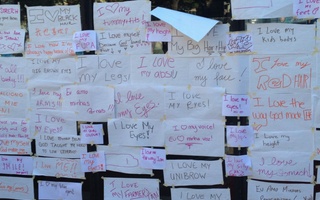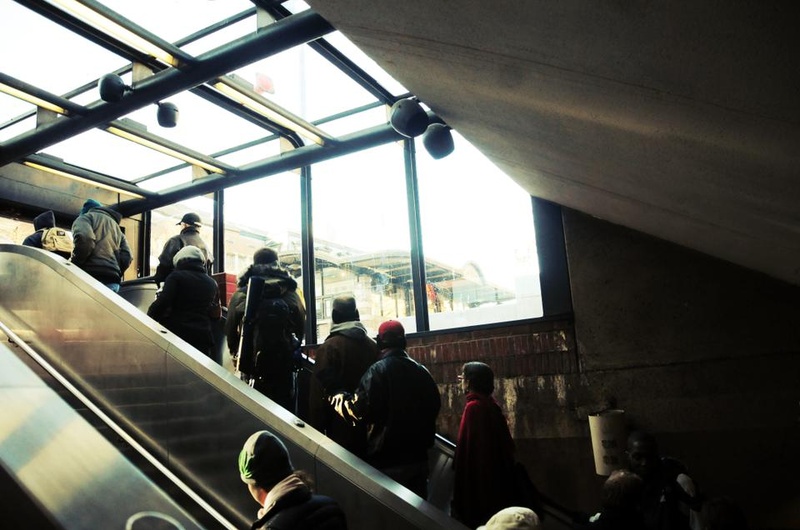A man holds a sign outside the Harvard Square T-stop offering a “Free Bible Quiz.”
Bruce M. Benson says his objective is not to convert people, but to start conversations with the people he encounters in the Square.
And the Pit, the sunken amphitheater that surrounds the T-stop entrance, seemed the perfect place for interesting encounters.
In the 1960s, he might have run into Bob Dylan or Joan Baez. But in the past twenty years, the Pit has been host to some less glamorous appearances.
Benson, who has lived in Cambridge for 18 years, recalls that in the early 1990s the Pit drew some unsavory characters.
“It was a free–for–all, open air mental institution,” he says.
In the past decade, Cambridge residents have raised concerns about violence and drug use among some frequenters of the Pit.
Still, store owners in Harvard Square say that the vibrance of the Pit is good for business: it sets the Square apart from the rest of Cambridge.
A HISTORY OF VIOLENCE
“Some people are uncomfortable of the gatherings of people there,” says Fred Berman, a planner for the Cambridge Department of Human Services.
“Rough characters” as well as the “transactions that happen outside the law” are a point of concern for some residents, he added.
In September 2000, three undergraduates were attacked by seven people they labeled “intoxicated skinheads,”—allegedly from the Pit—on Mt. Auburn St. The next day, a Muslim undergraduate was attacked on Bow St. as he walked back to his dorm from evening prayers in Canaday. His attackers were also later identified as skinheads who hung out in the Pit. Many in the Harvard community viewed the attack as a hate crime; the Harvard United Ministry organized a silent vigil at Memorial Church, followed by a peace march through the Pit.
But the violence didn’t end there.
In 2001 Io Nachtwey, a homeless woman who hung out at the Pit, was stabbed to death and thrown in the Charles by a gang-like organization from Boston that had recently begun to frequent the Pit.
Finally, in June 2003, three teenagers known to have spent time in the Pit were arrested after stabbing a man in front of Pizzeria Uno.
Residents also raised concerns in the early 2000s that the groups of people constantly congregating in the Pit created a potentially dangerous congestion problem.
In 2007 construction started on the Super Crosswalk Plan as part of the Harvard Square Improvement Project, which extended walking space and subsequently decrease congestion in the Pit. City officials report that there have been fewer complaints since the project was completed in 2008.
AN URBAN STAGE
Designed to facilitate spontaneous community performances, the Pit is much more than just home to the main entrance to the subway. It was built in 1985, at the conclusion of a process to extend the Red Line out to Alewife. Musicians, artists, homeless people, tourists, and protestors are all among the groups that use the space as a public gathering place.
In the 1960s, the Square was an early performing venue for folk singers Baez and Dylan, and the roaming lifestyle of that era has continued to define the Pit.
In the 1980s and ’90s, the Square became a gathering place for the Punk counterculture youth movement.
For $40 per year, performers and protestors—such as the Tibetan monks who often demonstrate there—can obtain licenses to perform in the Pit.
One such performer, Donald Heller of the Hurdy Gurdy Band, has been playing his hurdy gurdy—a type of violin that sounds similar to a bag-pipe—in or around the Pit for the past month.
After playing for two years on the streets of Europe, he and his wife Anicet Heller moved to Boston to be closer to their sons, one of whom goes to the Boston Conservatory of Music. Heller obtained a street performing license and, although it will expire at the end of the year, he said it worth the $40 for the few remaining months.
“It is a comfortable place for buskers [street performers]. That is what keeps me here” said Heller. He said that while the streets of Munich and Berlin have more open space for pedestrians, the Pit and the large sidewalk in front of Crema Cafe are good for performance. He also noted that the provisions that the city makes for performers are attractive to musicians.
“Our street performers are completely organic, there is complete serendipity,” Denise A. Jillson of the Harvard Square Business Association said. “They can show up in the morning and stay as long as they wish.”
GOOD FOR BUSINESS
In 2003, during the planning process for the Harvard Square Improvement Project, a City Council appointed committee concluded that because the Pit is a visible, public area, it is relatively safe. Furthermore, the committee said, if people were not allowed to hang out there, they might start congregating in less visible areas and could potentially pose a more significant safety issue.
But safety concerns do not appear to weigh heavily on the minds of local business owners.
Rather, business owners were happy to point to the Pit as a source of costumers and a unique aspect of Harvard Square.
Donez J. Cardullo, of Cardullo’s Gourmet Shoppe, notes that the Pit adds flavor to the square and without it, “It just wouldn’t be Harvard Square, it’d be Porter Square.”
She says that Cardullo’s has been in the Square for 59 years and the Pit hasn’t affected business and is “not a concern at all.”
Similarly, Chris Kotelly, the owner of Crimson Corner News Stand, which is directly across the street from the Pit, commented that as long as the young people in the Pit do not cause trouble, it is not a problem. He added, “Some of them are our costumers, I respect them.”
Rakesh Kaftey, an employee of Out of Town News also said that the Pit is a source of business, because many people who hang out there come in to buy cigarettes.
The area’s history as a spot for those off the beaten path has kept it a destination for youth and homeless people.
Some come to the Pit for the counterculture scene, while others stop in Cambridge during a longer journey, said Berman.
The Pit is like any popular bar or restaurant, Berman continued, people come because of its reputation.
—Staff writer Kerry K. Clark can be reached at kclark@fas.harvard.edu.
Read more in News
Senior Fellow Leaves BoardRecommended Articles
-
Ball FourIf watching football is anything like playing, I think I have a pretty good idea of what it felt like
-
Strangers In Our MidstIn the middle of the day only a few businesspeople, construction workers and local shopkeepers sit on the brick benches
-
A Man With a Machete is On the LooseThe Cambridge police are looking for a man with a machete.
-
Wanted: RoadiesWhat do you get by bringing together two aspiring doctors, an astrophysicist, a public servant, a religion expert and a ...
-
15 ListNow that construction plans in Allston have been paused indefinitely, here are FM’s suggestions for what Harvard can do with ...
-
 #lovethyself
#lovethyself














